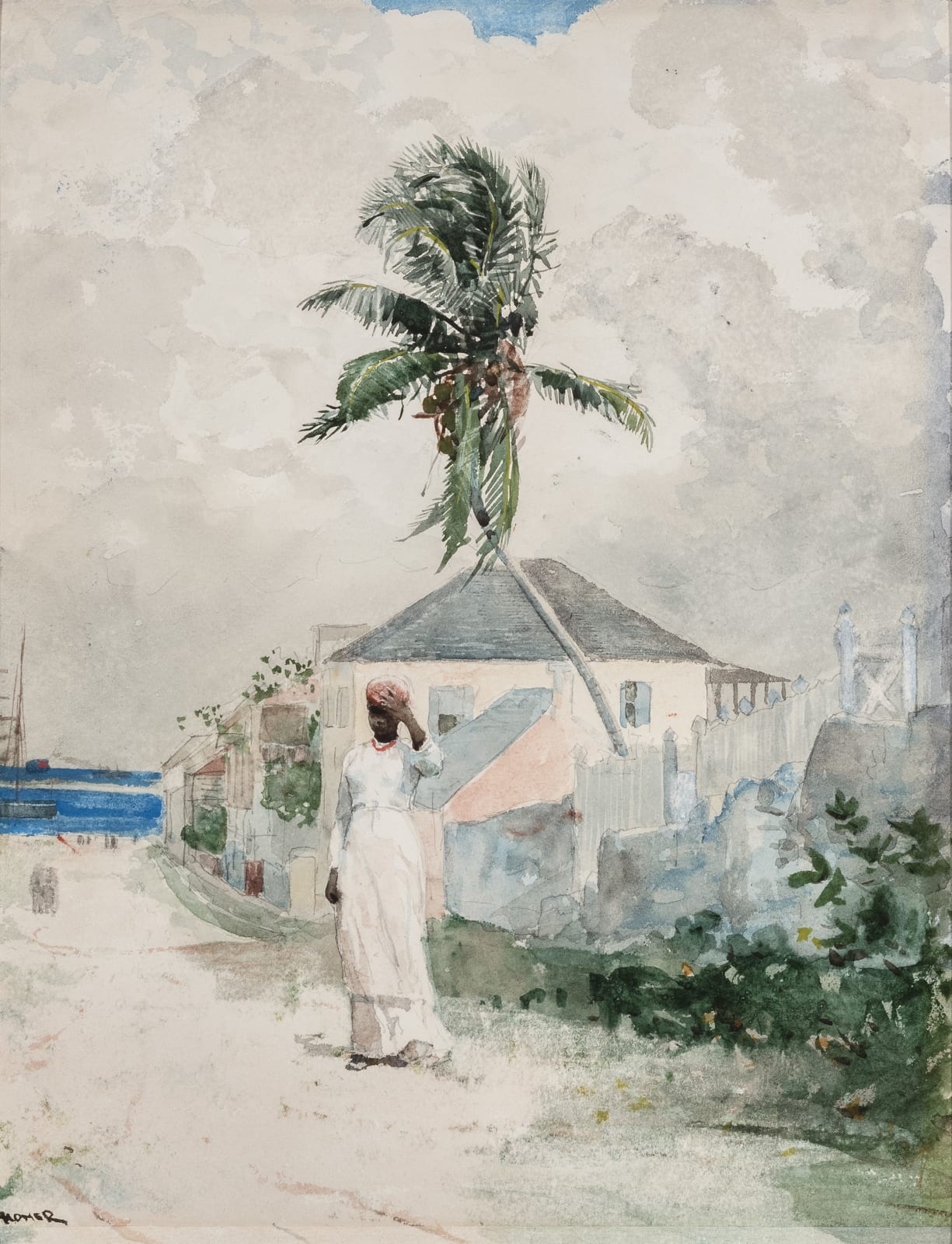Winslow Homer American, 1836-1910
45.7 x 35.6 cm
In 1885, Winslow Homer travelled to the Caribbean, commissioned by Century Magazine to produce a series of watercolors. His first stop, after Florida, in the Bahamas, produced a series of sketches, drawings, and watercolors, culminating in masterpieces as Sponge Fishing; sketches along the way to his next destination of Santiago, Cuba, produced Gulf Stream. The Century ostensibly commissioned Homer to document the city of Nassau, but Homer’s time in the Bahamas focused mainly on life at the water’s edge.
He stayed at the Royal Victoria Hotel, the largest on the island, making small trips to shore to produce a small group of sumptuous watercolor, of which the present work is an extraordinary example. It represents not only a summa of effects in Homer's repertoire, but also a major turning point in his treatment of watercolor. Helen Cooper observed:
Formally, the Caribbean light had a liberating – and lasting – effect on Homer’s watercolor style. The Bahamas sheets are painted with free and gestural strokes in transparent washes often in brilliant colors, leaving large areas of white paper exposed. Their style was undoubtedly affected by the conditions of their creation: painted outdoors, and quickly, before the watery pigment could dry under the hot sun. With fewer spongings, scrapings and lift-outs, they have a direct, seemingly unpremeditated execution. Homer was able suddenly to say things with ease that had before been communicated only with effort [Winslow Homer Watercolors, (1986), p. 134].
Abigail Gerdts traced clues to the location of the work's genesis:
This watercolor is probably the work titled "Near the Queen's Staircase" in the Reichard and Doll & Richards Homer exhibitions of 1885/1886, described in a Boston Transcript review: 'Near the Queen's Staircase' is one of the best . . . one can feel the wind that beats back the palm tree, rumples the sea into deep slate blue and sends the clouds bounding and scurrying across the sky." Four watercolors which had been in the recent exhibition of Homer's Bahamas and Cuban subjects were again received by Doll & Richrads from Homer in April 1886; three of the four were purchased by Edward W. Hooper that October . . . All three promptly came into possession of Hooper's first cousin, Mrs. Alice Mason, and her daughter Mrs. Edward Balfour, who lived in London and Scotland. It would appear Hooper purchased . . . [the present work as a] gift for Mrs. Mason or Mrs. Balfour [Winslow Homer Catalogue Raissone, no. 1261].
The title in the Doll & Richards show, while possibly not given by Homer himself, is nonetheless telling. The "Queen's Staircase," also known as "the 66 Steps," is a major landmark in Nassau, the sort of location that would have attracted the touring artist. The steps descend through a crevice that was carved out of the solid rock by slaves in 1793-94, and by tradition are said to connect Fort Fincastle with Nassau. The steps were later named for Queen Victoria in her honor, during her reign from 1837-1901. Whether or not Homer had this historical context in mind as a subtext for the interpretation of the work, he certainly identified the location as a reference point by which to identify the work. Subsequent titling omits this reference, and we join the authors of the catalogue raisonne in the more ambiguous naming of the site, reflecting the casual observation that the Queen's staircase is in any event not in view in the present work.
Provenance
The artist; to
[Doll & Richards, Boston, Massachusetts, 1886]; to
Edward W. Hooper, Boston, Massachusetts, 1886; to
Isabella Weyman Hooper Balfour (Mrs. Edward Balfour), Balbirnie, Scotland (his cousin); to
By bequest to Alice Georgiana Balfour, London and Fife, Scotland (her daughter), 1938;
Jean Drew Balfour (Mrs. John C. Balfour), Scotland (her niece-in-law, as a gift), 1957; to
Mr. and Mrs. Alan J. Balfour, Scotland (her son and daughter-in-law, as a gift), 1997;
[Sale: Christie’s, New York, May 21, 1998, lot 96]; to
Private collection, American Midwest, 1998-2020; to
[Menconi + Schoelkopf, New York, 2020]; to
Private collection, Texas, until the present
Exhibitions
Reichard, Boston, 1885, no. 12 (as Near the Queen's Staircase) (probably) // Doll & Richards, Boston, 1886, no. 8 (as Near the Queen's Staircase) (probably)Literature
"Art Notes: Winslow Homer at Doll & Richards's, February 19-March 3," Boston Daily Evening Transcript, February 25, 1886 // Miles Unger, The Watercolors of Winslow Homer, New York, 2001, p. 126, illus. // Lloyd Goodrich and Abigail Booth Gerdts, Record of Works by Winslow Homer, vol. IV.2, New York, 2012, p. 316, illus. p. 137


